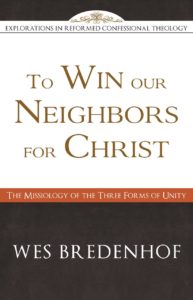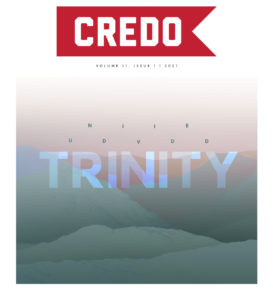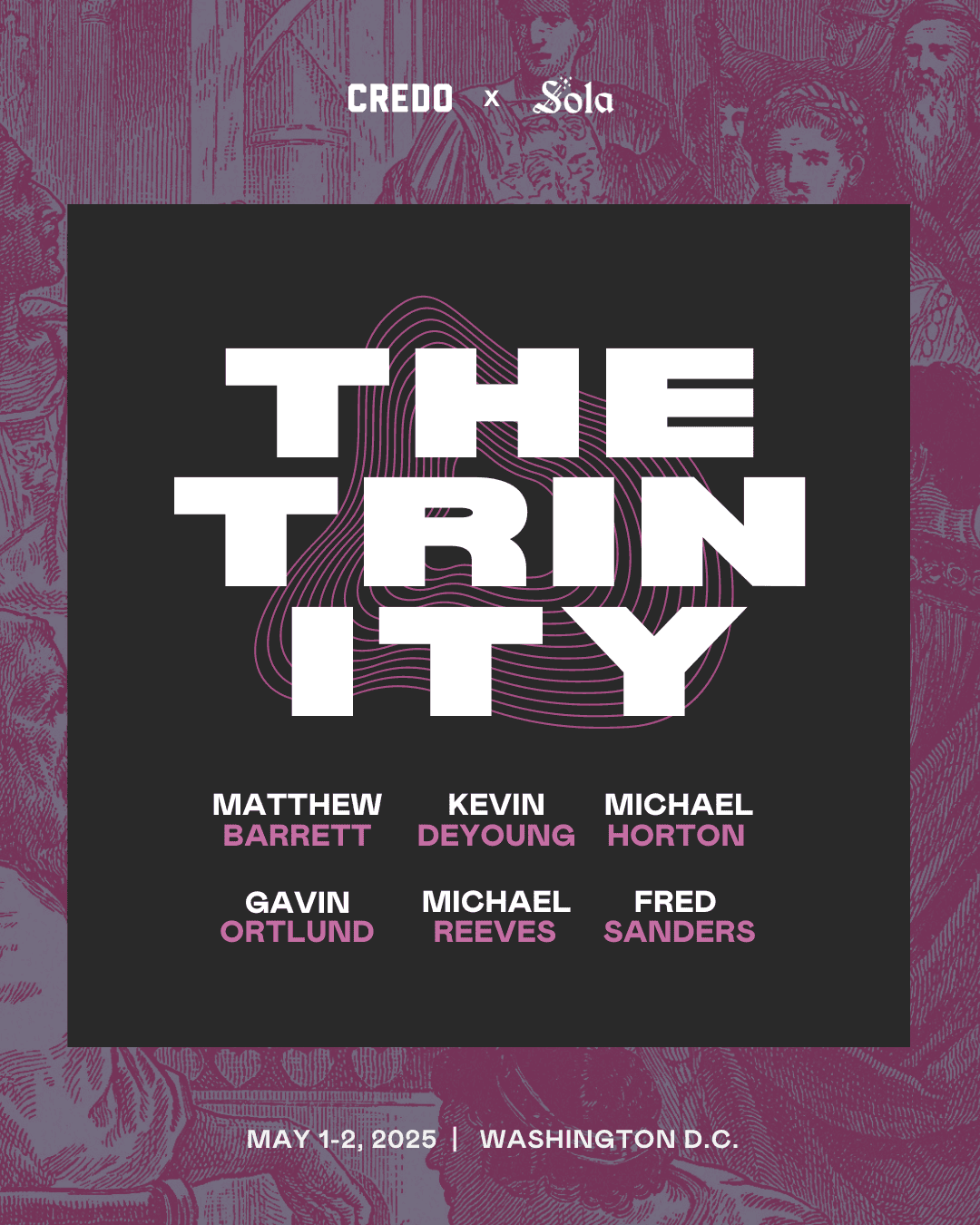The “Three Forms of Unity” mentioned in the subtitle to Bredenhof’s book, To Win Our Neighbors for Christ: The Missiology of the Three Forms of Unity (Reformation Heritage Books), is the collective name given to the Belgic Confession (1561), the Heidelberg Catechism (1563), and the Canons of the Synod of Dort (1619). Along with the ecumenical creeds, these constitute the confessional documents of the churches that lie downstream of the Dutch and German Reformed Reformations. (Don’t panic if you don’t know which they are; you can almost always pick them out by noting the word “Reformed” in their denominational designations.)
(Don’t panic if you don’t know which they are; you can almost always pick them out by noting the word “Reformed” in their denominational designations.)
If you’re unfamiliar with these documents, you should get to know them. They provide as exemplary a conjunction of precise theology, pastoral wisdom, and personal piety as you’re likely to encounter anywhere—and all the more so among confessional documents!
If you do know the Three Forms (or if you think you know them), you’ll perhaps be surprised to learn that they have a missiology. After all, missiology textbooks typically make the claim that the Reformation produced no missionaries but rather a lingering “missions-lukewarmness” (p. ix). Rather, they assert, the age of missions began in earnest only after the publication of William Carey’s Enquiry into the Obligation of Christians to Use Means…. (1793) and only in the nineteenth century did missiology begin to develop into a distinct discipline. By contrast, the Three Forms never even mention “missions” or “missiology.”
I have to admit that I was curious about the types of argument the author would be able to muster, and when the book arrived I had to restrain a chuckle. Perhaps the size—ninety-three smallish pages of text—suggested that there really wasn’t much to say on this topic. I stand corrected. Thanks to To Win Our Neighbors for Christ, I now find myself reading the Three Forms with clearer and, if you will, more missiologically attuned eyes, for the book’s basic argument is compelling, even if that argument raised more questions in my mind than it answered.
Let me back up. Bredenhof does two things in this book. First, he argues that we’ve misunderstood (or, rather, failed to notice) the missiology of the Three Forms because most modern readers have a different understanding of what missions are than did the authors of the Three Forms. Yet, he suggests, the older approach to missions is coherent, robust, and biblically rooted. Second and consequently, because their confessional documents have a thoroughgoing missiological agenda, churches that subscribe to them must reflect that “outward orientation” (p. 86). If the first point is correct, I take it that the second one follows almost necessarily.
So, how does Bredenhof re-read the missiology-less Three Forms as missiological texts? The answer is: excavation. He uncovers the layers of meaning that lie hidden in comments and citations that we pass over without recognizing their full significance. He explains that their authors and audience understood themselves to be living in what we might now call an active missions field, one composed of neighbors who gave their religious allegiance to the theology codified at the Roman Catholic Council of Trent (1545-63). For example, the martyred author of the Belgic Confession understood “the Reformed faith as the only path to salvation” and that “to turn one’s back on that faith [was] to be lost” (p. 12). Therefore, to confess the truth of the gospel with the church was to testify to that gospel to the world and to invite those who were outside to come in.
As this suggests, Bredenhof argues that the Three Forms collapse any substantive distinction between evangelization and missions (pp. xii-xiii). In effect, the reason why we don’t recognize the missiological agenda of the Three Forms is because we tend to assume that missions are either tangentially related to the work of churches “back home” with their elders and deacons and formal church membership or that such structures have no bearing on the work of trailblazing lone-wolf missionaries. By contrast, the missiology of the Three Forms demands that the ongoing proclamation of the gospel by word and deed to immediate neighbors and to all the nations of the world be a work of the “established church” (p. 37). The missiology of the Three Forms demands that the ongoing proclamation of the gospel by word and deed to immediate neighbors and to all the nations of the world be a work of the “established church” Share on X
Unfortunately, Bredenhof’s argument is too brief to demonstrate this conclusion, and the whole project deserves a lot more development and contextualization than it gets. In the author’s defense, he did publish a longer book just on the Belgic Confession that excavates that document more thoroughly. Even so, we are largely left to wonder whether the Three Forms did, in fact, motivate early modern Christians whose theology, piety, and practice were shaped by them to pursue missionary activity beyond the bounds of the Netherlands.
While Bredenhof offers several examples of modern-day missionaries using the Three Forms in their labor and even briefly refers to the Dutch effort to proselytize in seventeenth-century Brazil, the evidence marshalled is underwhelming. We’re left to wonder whether the Three Forms really motivated contemporaries to spread the gospel to the ends of the earth. (By the way, they did… but it’s a complicated story that involves the role of the Dutch in the first great wave of globalization from about 1450 to 1800.)
So, what should we make of this? I’ll offer two takeaways worth pondering.
First, Bredenhof raises challenging questions about the way that we conceptualize missions and the Great Commission in a post-”great age of missions” world. There are many good things to say about William Carey, but one of the unfortunate (and unintended?) legacies of his bombshell Enquiry is that it has produced a vision of missions that divides the effort into goers and senders—the real missionaries and those back home who do their bit by offering up money and prayers. Bredenhof helpfully reminds us that the whole church is called to confess Christ before our neighbors that we might win some (1 Cor. 9.22). Bredenhof helpfully reminds us that the whole church is called to confess Christ before our neighbors that we might win some. Share on X
Second, many of us in the West have recently realized just how far our own society has drifted away from Christian moorings. What appeared to be a slow veering off course has suddenly accelerated in unexpected and uncomfortable ways. I was struck by the fact that, in this, we are more like our sixteenth-century forebears than we might have imagined. They too awoke to find themselves surrounded by opposition to the gospel. Their success in navigating those treacherous waters is closely connected to the fact that their churches produced and rallied around confessional documents like the Three Forms of Unity. They functioned as a Rule of Faith, a clear articulation of the heart of the apostolic gospel message for their context. We would do well to follow their model. Let’s take another look at these Reformation documents and see if they don’t help us collectively confess where we stand, both at home and abroad.


